It's clear that smartphones are not only integrated into our daily business activities, but also integrated into our daily lives. In the past, smartphones were defined as cellular phones that used a proprietary operating system (OS). This means that smartphones can add or install/delete applications, although this definition is a bit simpler. Today's smartphones have become a small device that combines communication, entertainment and computing functions (Figure 1, Figure 2, Figure 3).
This article refers to the address: http://
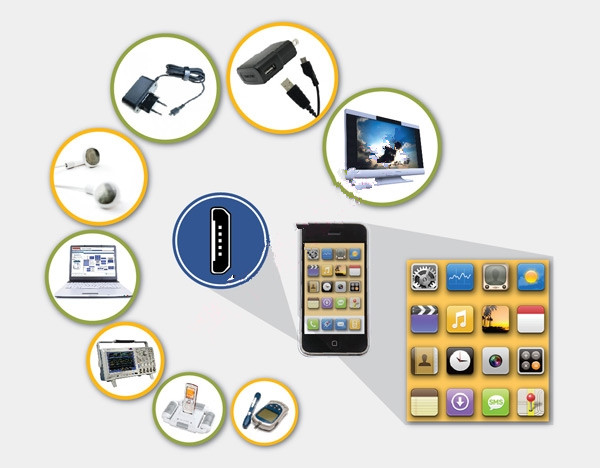
Figure 1: The smartphone interface with a micro USB port creates a “all-round†device with a smaller form factor.
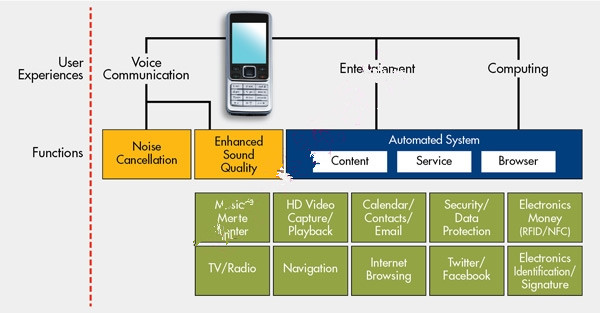
Figure 2: The smartphone can perform a variety of communication, computing, and entertainment functions.

Figure 3: Worldwide smartphone shipments continue to increase.
What do customers want?
Customer demand for price and specifications/performance is difficult to define. Currently, the average mid-range smartphones with acceptable performance are around $100 to $150. These phones feature an ARM11 600MHz processor, a partial touch screen panel/simple QWERTY keyboard and a basic media player.
High-end smartphones will offer full-size capacitive touch screen panels, high-performance media players, high-speed application processors, digital cameras over 8 megapixels, GPS/AGPS, and a variety of sensors for motion detection. Due to the large differences in configuration, the price of these smartphones is much wider than that of low-end phones, ranging from $250 to $350. In addition to hardware considerations, end users will also consider integrated services or value-added services (such as video/movie downloads, online digital stores, online video games, social networks, and mobile app stores). While not directly increasing the retail price of smartphones, these services are very important to service providers because they have a large impact on average revenue per user (ARPU).
Since the ARPU value of high-end smartphone users is 1.5 to 2 times that of ordinary 2G/3G mobile phone users, providers generally offer more attractive compensation plans for customers who purchase high-end smartphones. Currently, the four major companies dominate the mobile app store, they are Apple, Google, Nokia and RIM. These companies have a market share of more than 65%.
In terms of performance requirements, smartphone users are still showing great interest in downloading games and other applications. However, if you use a low-end smartphone, not all users can fully appreciate the fun, because these phones can not meet the processor speed and hardware configuration required to handle a large number of the latest games and applications.
In addition to communication, computing, and entertainment features, designers are pursuing other applications such as security/surveillance control, mobile payments, and e-wallets using Near Field Communication (NFC) technology. For example, with HSDPA/Wi-Fi and high-performance computing processors, smartphone users can use indoor network cameras as remote security controllers or baby monitors.
Smartphone operating system
At the end of 2011, Android has become the most popular operating system - the operating system is expected to account for 49% of the smartphone market in 2012 (Figure 4). Although Apple's share will decline slightly in 2012, its iOS will remain the second largest in the world by 2014. However, iOS can only be used on Apple's iPhone platform and will not be released/licensed to other mobile phone manufacturers.
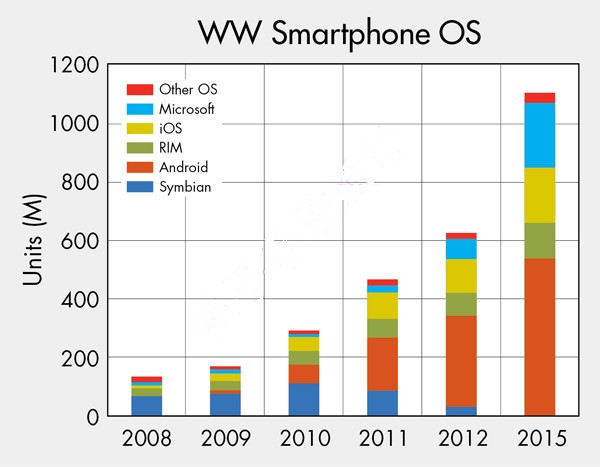
Figure 4: Gartner provides forecasts that Android will be the most popular smartphone operating system in 2012.
There are several major factors in the popularity of smartphones based on the Android platform:
Because Android is free, this operating system has attracted the attention of many manufacturers around the world, and many manufacturers initially chose it to design low-cost smartphones.
Unlike other operating systems that are heavily copyrighted, Google chose to open Android to everyone. As a result, the company has attracted a large number of programmers to develop applications while minimizing responsibilities. With so many people working on this system, Android can integrate newer, better ideas.
Unlike other mobile operating systems, device manufacturers can freely modify Android to their individual needs. Users can enjoy the much-needed flexibility and ease of use, as manufacturers can now modify whatever they need to enhance the user experience.
Android supports Adobe Flash-based websites.
Android smartphone users can easily run multiple different tasks simultaneously. As smartphones gradually replace PCs and MACs, this multitasking capability will become increasingly important in the future.
Challenging features
As smartphone functionality continues to improve, hardware specifications require greater power consumption to achieve targeted performance. Increasing battery capacity is the easiest way to meet this requirement, but this can result in increased volume, weight and material costs.
The typical feature phone has a battery capacity of approximately 600 to 750 mAh and is capable of supporting approximately 350 minutes of talk time and three days of standby time (Figure 5). Ordinary smartphones have a battery capacity in the range of 1000 to 1800 mAh, which should have a longer talk mode and talk time, but in fact, the standby time is only about one day, and the talk time is only about 350 minutes.
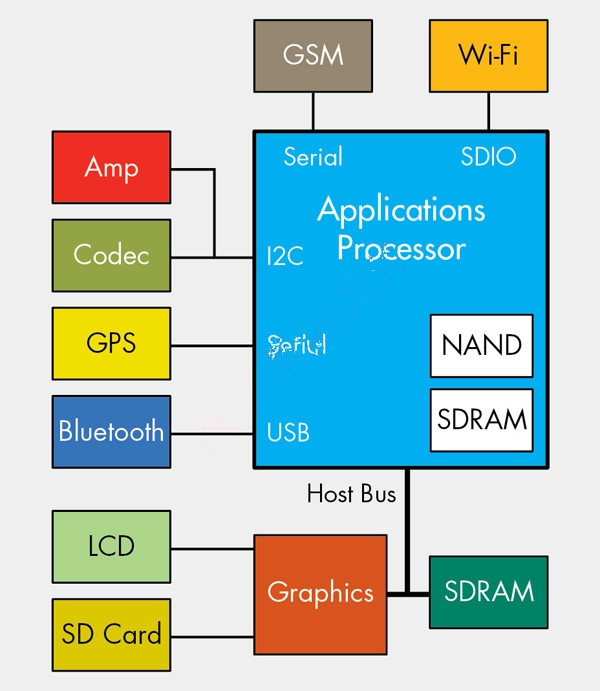
Figure 5: A typical smartphone with typical features shown has a battery capacity of approximately 1000 mAh to 1800 mAh.
This major difference is related to the data working mode of the smartphone. Users can access the mobile Internet and mobile messengers, check/write emails, etc., while the device continues to access the service provider's network for data exchange. Therefore, it is impractical to further increase the battery capacity, because this will make the smartphone too bulky and somewhat "smart".
In view of this, while extending the working hours of smartphones, maintaining a smaller battery size has become an important consideration in hardware design. In smartphones, RF power amplifiers (RFPAs), LED backlights, application processors (APs), and Wi-Fi modules consume more than 75% of battery power. Increasing the efficiency of these aspects can significantly extend the working/standby time of your smartphone.
Solutions to reduce LED backlight power consumption and improve DC-DC efficiency of AP or Wi-Fi modules can be easily found on the network. However, solutions that reduce RFPA power consumption and shorten battery pack charging time are not so easy to find.
Innovative features are a key motivating factor for smartphone manufacturers to introduce new models. These features should satisfy the user's "smart" desires and eventually become a differentiating factor from the competition.
Reduce RFPA power consumption
The smartphone market has witnessed many of the latest and most advanced hardware designs, such as Fairchild Semiconductor's FAN5904. This is a 6W, 3/6MHz buck converter that supports GSM/EDGE PAM and 3G/3.5G RFPA. Space saving is achieved because no two separate buck converters are required.
The FAN5904 is capable of meeting the global popular 3G wireless standard from WCDMA to HSUPA+ and CDMA2000 1x EV-DO. It also supports China's 3G standard TD-SCDMA and HSUPA supporting higher data rates in TD-SCDMA signal modulation. The FAN5904 converter can also be used in the emerging "TEDGE" mobile handsets. The phone supports TD-SCDMA and is backward compatible with GSM/EDGE. Figure 6 shows how the FAN5904 connects to a baseband chipset, RF transceiver, and amplifier.
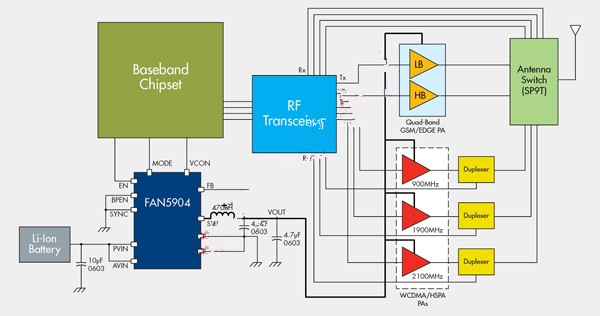
Figure 6: The Fairchild FAN5904 buck converter supports a baseband processor, RF transceiver, 3G amplifier, and GSM/EDGE PAM.
Viewing the output power sweep of a 3G amplifier with and without the FAN5904 for voice and data transmission (with RFPA supply voltage setting for -39dBc ACPR), it can be found that the converter can be used with the same size battery pack The talk time and data transfer time were extended by 14% and 30%, respectively (see Figures 7 and 8, respectively). This allows smartphones to use smaller lithium-ion battery packs without sacrificing overall talk time and data upload time (Figure 9). The smaller battery pack can greatly reduce the size of the entire phone, making the phone thinner, lighter and smaller.
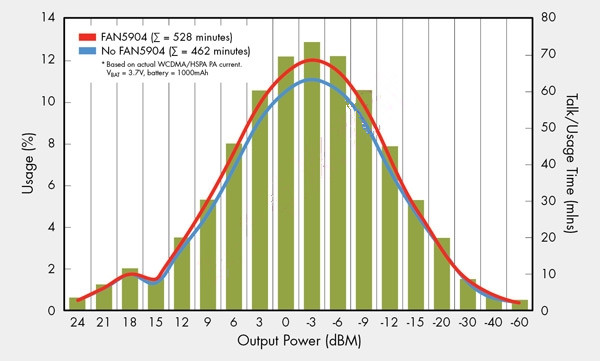
Figure 7: This figure compares the talk time of a 3G power amplifier with and without the FAN5904 in a WCDMA signal modulation mode and a 1000 mAh lithium-ion battery.
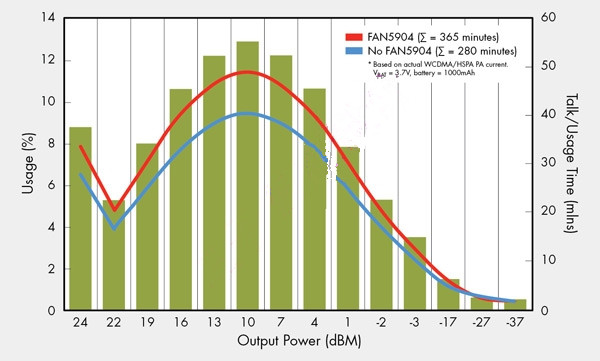
Figure 8: This figure compares the data transmission time of a 3G power amplifier with and without the FAN5904 under WCDMA signal modulation mode and 1000 mAh lithium-ion battery.
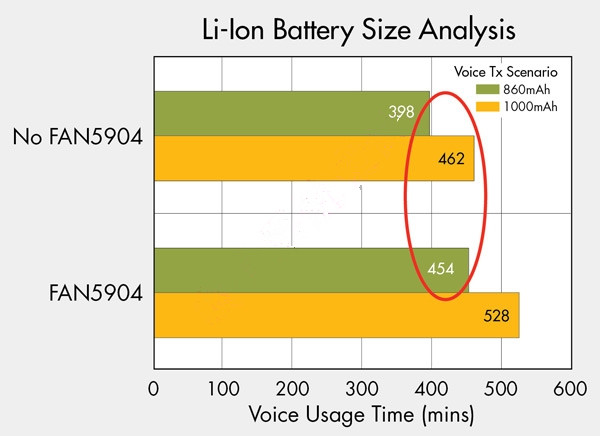
Figure 9: The FAN5904 converter allows for a reduction in battery pack size without sacrificing talk time.
Another advantage of implementing a DC-DC solution is the ability to greatly reduce the RFPA case temperature. For ease of description, the 3G RFPA powered by the FAN5904 was thermally imaged (Figure 10), where the FAN 5904 was directly connected to a battery that had been charged to 4.2V. In the case of the FAN5904, the temperature of the RFPA is almost less than 50 °C at full output power. However, in the other two cases, the temperature is easily reached to 50 ° C and 65 ° C. Therefore, after a period of use, the entire phone will heat up quite quickly.

Figure 10: These thermal images show a 3G power amplifier with FAN5904 (POUT = 28dBm) (a) at VPA = 2.97V, a power amplifier (b) only at VBAT = 3.70V, and only at VBAT = 4.20V Amplifier during battery charging.
In summary, the DC-DC solution not only helps to lower the temperature, but also simplifies the design of the thermal structure of the RFPA. Components can be placed closer to the RFPA, helping to reduce PCB size and cost.
Shorten the charging time of lithium ion battery
Cell phone batteries are typically charged using a standard USB port (5V/500mA) and an external charging adapter. Since the smartphone battery pack is relatively large, the charging time will be longer when using the traditional linear charger operating mode. This can be improved by increasing the charging current to 1C, but the phone battery must be connected to an external charging adapter (although not for standard USB ports). Admittedly, the 1C charging mode can also cause heat dissipation problems in the charger IC - when the external charging adapter is connected to the phone, the casing becomes very hot. Therefore, designers generally need to reserve a portion of the PCB space for heat dissipation.
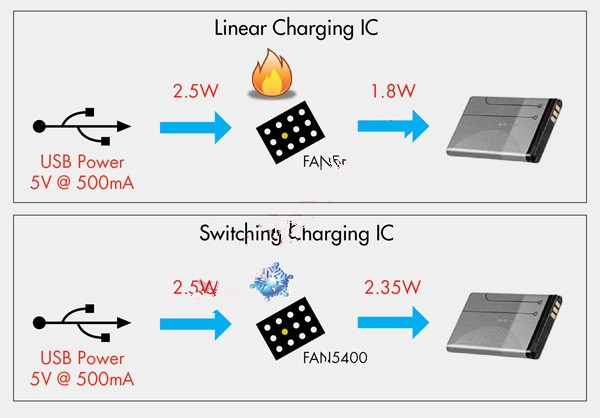
Figure 11: The efficiency of a typical linear charger is about 70%, while the efficiency of a switching charger is close to 94%.
Traditional linear chargers are similar to low dropout (LDO) regulators with efficiency up to 70% (Figure 11); switching chargers are similar to DC-DC converters with up to 94% efficiency. Even when connected to a standard 5V/500mA USB port, the switching regulator can support up to 650mA of charging current. For example, when using the same configuration as the 900 mAh battery pack, the charging time takes 1 hour and 12 minutes. The overall charging time is reduced by 30% and the case temperature is reduced below 40°C (Figure 12).
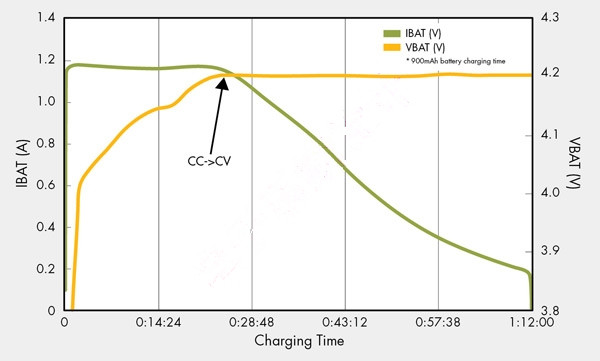
Figure 12: Using the FAN5400 Switch Charger can reduce charging time by 30%.
The FAN540x switching regulator can be used to reduce charging time and simplify thermal design. This switching regulator features ±5% high precision input overcurrent protection (OCP) and ±0.5% charge overvoltage protection (OVP) accuracy. OVP and optional input OCP provide additional protection for rechargeable batteries.
Dual camera resolution
Most smartphones are equipped with two cameras: a high-resolution camera for taking photos and a standard-resolution camera for video calls. The two cameras share the same data bus and isolation switches that protect signal integrity in high-speed resolution mode.
To meet these needs, manufacturers have developed different types of solutions. For example, Fairchild's FSA1211 low-power, 12-port high-speed switch is configured as a single-pole, single-throw (SPST) device optimized for isolated high-speed sources such as cell phone camera interfaces (Figure 13). The FSA1211 has a turn-on capacitance (CON) of 6pF, and its wider bandwidth (>720MHz) passes through the third harmonic, resulting in very small edge and phase distortion (Figure 14). In addition, crosstalk between channels minimizes interference.
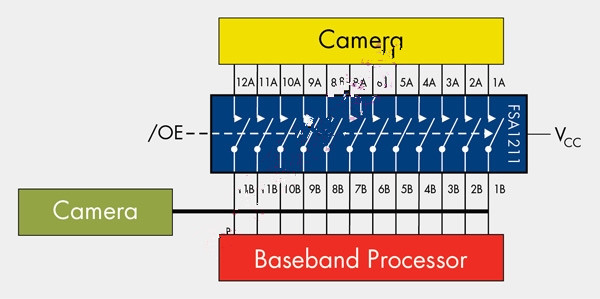
Figure 13: The FSA1211 single pole single throw high speed switch can be used to isolate high speed sources.
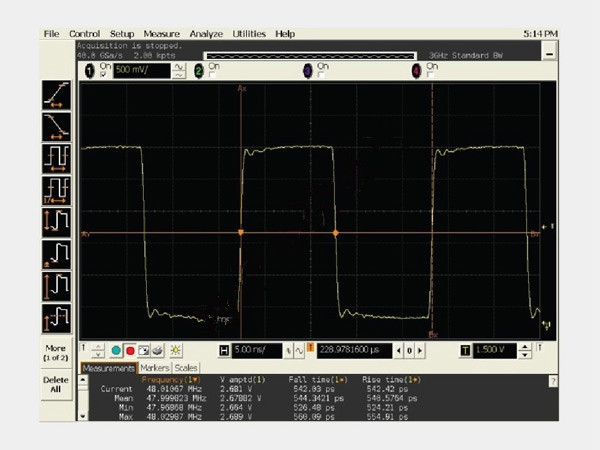
Figure 14: With signal integrity at 48MHz, the FSA1211 minimizes edge and phase distortion.
In addition to using parallel interfaces, manufacturers also use the Mobile Industry Processor Interface (MIPI) for high-speed interfaces to MIPI modules such as cameras or LCD displays. Following the above ideas, Fairchild developed the FSA641 and FSA642 switches.
The FSA641 is a 2:1 MIPI switch used primarily for dual data channels and single data channel modules (Figure 15). The FSA641 is configured as a single pole double throw (SPDT) switch optimized for switching between two high speed or low power MIPI sources. This device is specifically designed for the MIPI specification and allows connection to CSI or DSI modules. The FSA641's CON is 8pF. Like the FSA1211, its wide bandwidth (>720MHz) passes through the third harmonic, minimizing signal edge and phase distortion. Similarly, crosstalk between channels minimizes interference.
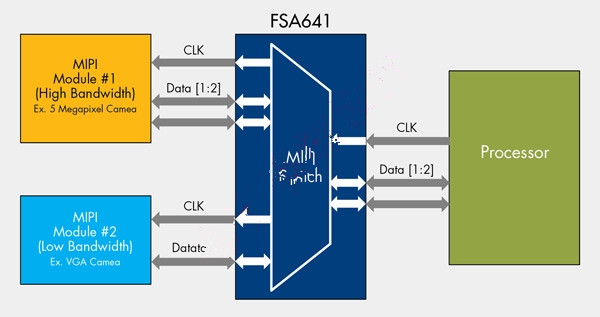
Figure 15: The Fairchild FSA641 is a 2:1 MIPI single pole double throw switch that handles dual data channels and single data channel modules.
The FSA642 is a bidirectional, low power, high speed analog switch with a pinout for easy differential signal layout (Figure 16). The FSA642 is configured as a three-pole, double-throw (TPDT) switch optimized for switching between two MIPI devices such as a camera or LCD display and an onboard multimedia application processor (MAP).

Figure 16: The FSA642 is configured as a three-pole, double-throw (TPDT) switch. This high-speed analog switch provides pin outputs that facilitate differential signal layout.
Single connection port
Micro USB has been widely used in various charging and data transmission devices (Figure 17). A standardized charger interface can reuse the charging adapter, which reduces overall cost and is more environmentally friendly. Some handset manufacturers are switching to micro USB connectors for charging, audio and data transmission, a move that will help further reduce handset size.
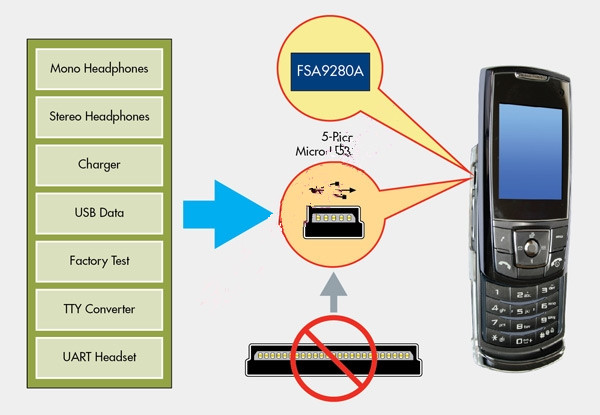
Figure 17: A single 5-pin micro USB port manages a wide range of functions.
For example, Fairchild's FSA9280A is ready to replace the existing manufacturer-specific connector with a standard mini/micro USB connector. It saves space and standardization by allowing multiple accessories and signals (USB data, stereo and mono audio, UART data and charger detection) to be shared across a single USB port.
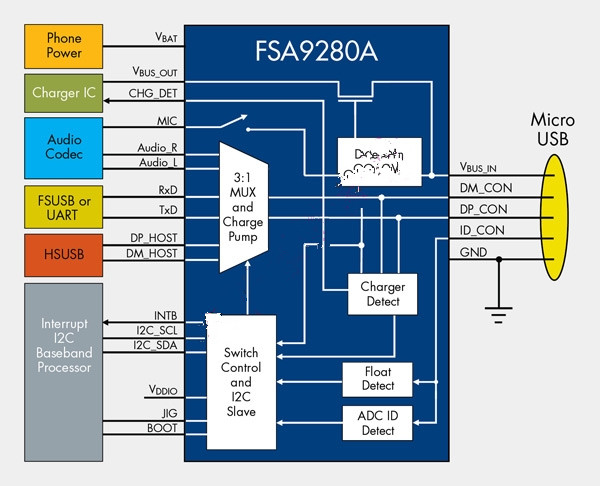
Figure 18: The FSA9280A supports the replacement of existing manufacturer-specific connectors with standard mini/micro USB connectors.
A Cabin Air Filter is an air purification filter, sometimes called a [micro cabin Air Filter" or [in-cabin microfilter," designed to remove the microscopic dust, allergens, pollutants and other particles that come into the passenger cabin of your vehicle through its air vents. In addition to making the air in the interior of your car unpleasant and unhealthy, a dirty cabin air filter, clogged with dirt, dust, smelly mold and allergens, can also impact the performance of your defroster, heating and AC.
Cabin Air Filter
Automotive Cabin AirFilter,Car Activated Charcoal Cabin Air Filter,Cabin Air Filter,Auto Cabin Filter
Donguan Bronco Filter Co., Ltd , https://www.broncofilter-cn.com